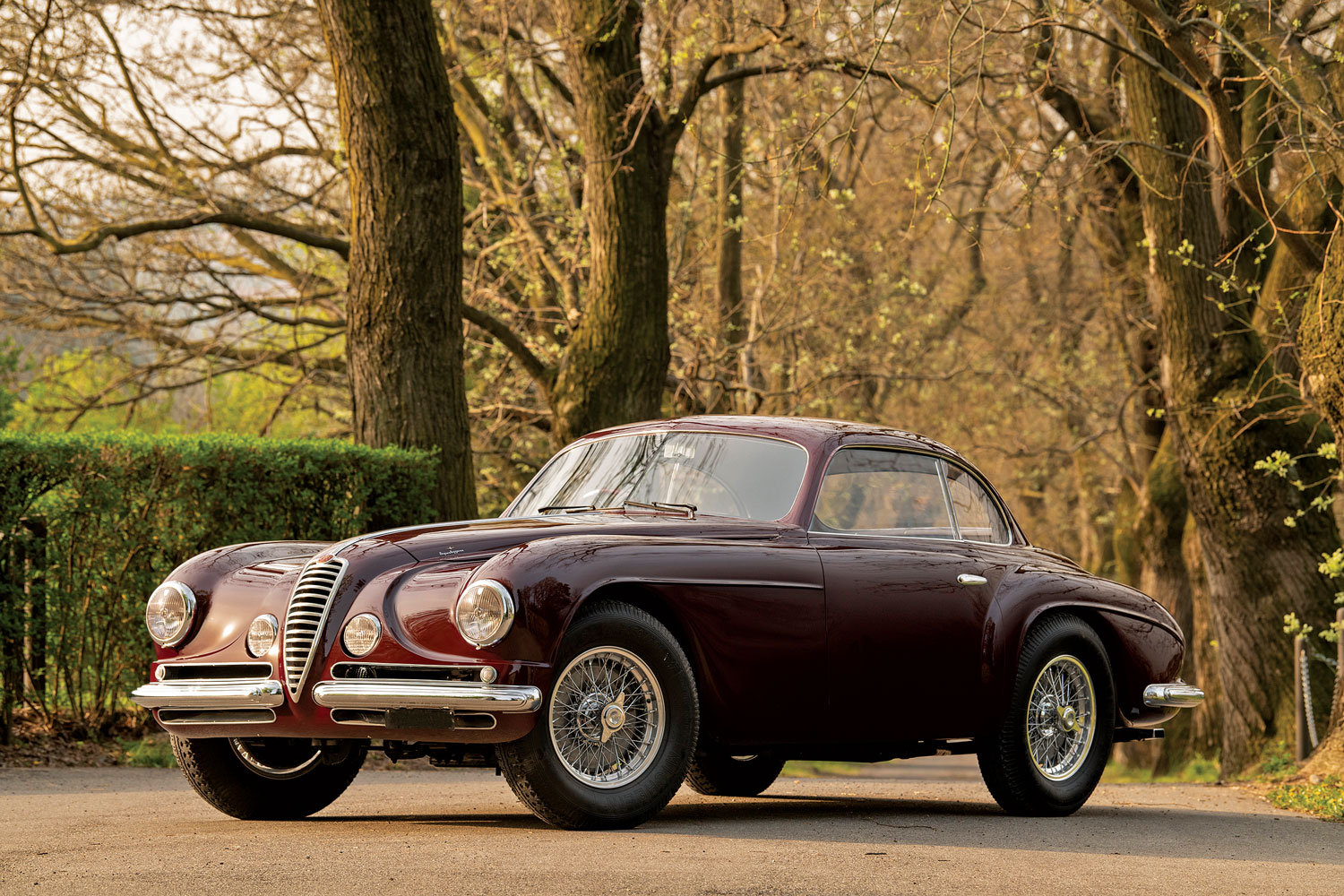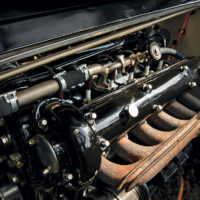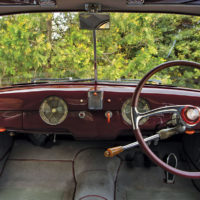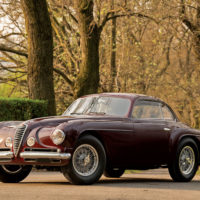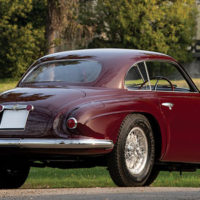Bridging the gap between the pre- and post-war eras, Alfa Romeo’s 6C 2500 debuted in 1939 as the third series of Vittorio Jano’s legendary 6-cylinder Alfa Romeos. Capable of 160 km/h, these cars benefited from four-wheel independent suspension and could be had in a handful of levels of tuning. This included the 87-horsepower Turismo, moving up to the 110-horsepower Super Sport, or SS, and culminating in the track-ready Tipo 256 with 120 horsepower.
Following the war, the first 6C 2500 offered was the Freccia d’Oro, which boasted essentially the same running gear as the pre-war cars. In 1949, Alfa Romeo introduced the Villa d’Este coupes. Boasting Superleggera coachwork by Touring of Milan, Alfa Romeo dubbed the car “Villa d’Este” following this design’s success at the Concorso d’Eleganza at Villa d’Este on Lake Como, where it won the Gran Premio Referendum, also known as the People’s Choice Award.
From 1949 to 1952, just 32 Villa d’Este coupes were built, in addition to five cabriolets. This would mark the end of 6C 2500 production (with the exception of a couple of racing cars built in 1953), signaling the end of this legendary era of hand-built Alfa Romeos.
Chassis number 915913 was delivered new to Paris in August of 1951. Its early history is not entirely clear, but at some point in the 1950s, the car was involved in an accident. It was shipped from France to the United States in the early 1960s. A photograph of the car is included in the history file, showing it fitted with an Aerlux sunroof. At this time, it was owned by Richard Martgan in Texas and was finished in red with a red-and-blue interior.
Passing through Jan Bruyjn in the Netherlands in the early 1990s, the 6C 2500 returned to the United States, where it remained until at least 2014, and was subsequently exported to Italy. The car was acquired in 2013 by the consignor from Bruno Galatassi, who in his 10 years of ownership had restored the car to how it appears today, finished in beautiful maroon paintwork with a gray cloth interior.
Following the consignor’s acquisition, the Alfa Romeo has been driven in the 2015 Gran Premio Nuvolari, the 2017 Mille Miglia, the Coppa Milano-Sanremo in 2018, and has been shown regularly at the Concorso d’Eleganza Villa d’Este. The car’s participation in those events speaks to its desirability, as it would surely be welcome at a variety of further tours or concours.
SCM Analysis
Detailing
| Vehicle: | 1951 Alfa Romeo 6C 2500 Super Sport Villa d’Este |
This car, Lot 111, sold for $775,669 (€640,625), including buyer’s premium, at RM Sotheby’s Milan, Italy, sale on June 15, 2021.
ALFA was created in 1910 in Milan, morphing into Alfa Romeo in 1920 when taken over by Nicola Romeo. Over the next 20 years the company would gain a formidable reputation for its sporting and race cars that reached far beyond the borders of Italy. Despite their modest, 2,300-cc displacement, Alfa’s supercharged inline 8-cylinder cars from the early 1930s are considered by many to be the world’s first “supercars.”
But an automobile manufacturer can rarely survive producing only sports cars. In 1934, Alfa introduced the 6-cylinder 2300, aimed at a less-sporting clientele. It would be Alfa’s mainstay for nearly 20 years.
The twin-cam engine was not supercharged, and the chassis, made in various lengths, was traditional, with leaf springs all around. Power was adequate but not thrilling. The rolling chassis were generally sold to individual customers and coachbuilders bodied them as they saw fit. Results ranged from boring 7-seater passenger cars to stunning 2-door cabriolets and coupes.
Some ultra-light race cars with hot engines were reasonably successful in the myriad sporting events of the time, but the target was the well-heeled middle class.
Pre-war to post-war
The chassis evolved and was soon incorporating independent suspension. In 1939, just before the hostilities of World War II commenced, Alfa upgraded the engine to 2,500 cc, offered either in “sport” or “super sport” tune, the latter capable of speeds exceeding 100 mph. They weren’t rocketships, but power was sufficient for grand touring at the time.
A number of chassis were laid up during the war, so production restarted shortly after its end. By 1950, however, the 2500 chassis and engine were outdated and, worse, Alfa stubbornly continued to produce the cars in right-hand drive with a column shift. But if you wanted a luxury family car in Italy, no competition existed.
Coachbuilt tradition
The early post-war period in Europe was a time of austerity, but the glamour of coachbuilt cars helped the image of Alfa’s aging mechanicals. Alfa produced its own bodies for saloons, and these were the mainstay of the business. Pininfarina and Touring, on the other hand, were simply unable to build a 2-door that didn’t look stunning. The designers at Touring, especially, produced coupes that were easily the best looking in the world. These cars found clients not just in the industrial heartlands of northern Italy, but internationally as well.
The Touring coupe was built in two different versions. The almost identical lines were available with either one or two side windows. The single-window cars look more sporting, while two-window “Villa d’Este” cars are more elegant. Production of the two-window version didn’t start until 1949, over two years after the single-window cars. After a little hesitation from potential customers, it soon dominated Touring’s production. But the small market for these bespoke motorcars translated into a run of only about 30 examples during a three year period. (Although the catalog states 32 were built, no exact production numbers exist.) Today, the Villa d’Este is slightly more desirable, perhaps due to its rarity.
To underline how special these cars were, chassis 915913 was delivered new to Paris. To legally import a foreign automobile at the time, the person or company had to earn the right by exporting French goods abroad. Very few could benefit from this privilege.
Let the sun shine in
Our subject car retains its original Super Sport engine, which is not always the case with vintage Alfas. The car’s condition appears to be very good, but not finished to a class-winning concours standard.
This was one of the last two coupes to leave the Touring workshops, with desirable wire wheels and an “Aerlux” sunroof. The sunroof was made in Perspex and did not slide, only opening slightly at the front leading edge. At some point in the car’s life, it was removed and metaled in. If the car had still possessed the Aerlux sunroof, bidding probably would have went a little higher, with the sale price possibly exceeding $800k.
Body restoration on Touring “Superleggera” construction is notoriously difficult, and the Alfa engine is fairly complex. But this car has seen some arduous driving since its restoration, so its new Swiss owner took a gamble that the work was done correctly. He can now compete in prestigious events, such as the Mille Miglia, or simply wow everyone at Cars & Coffee.
The price paid was right on the money in today’s market, with the prospect of some profit in the future. Sartorial elegance never goes out of fashion. ♦
(Introductory description courtesy of RM Sotheby’s.)
